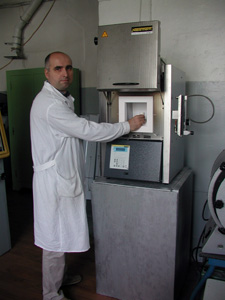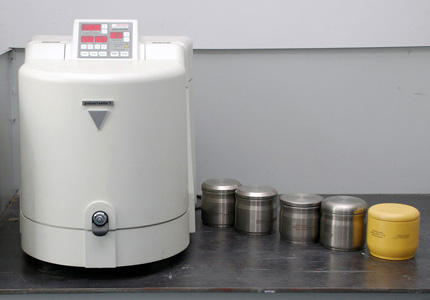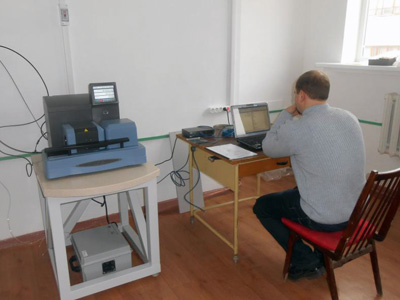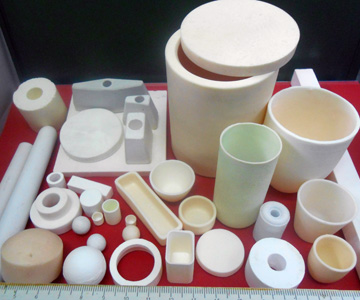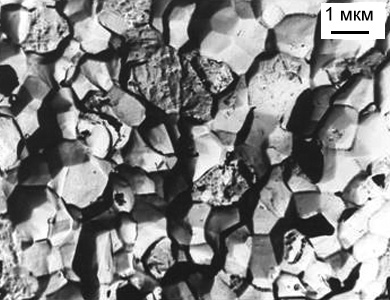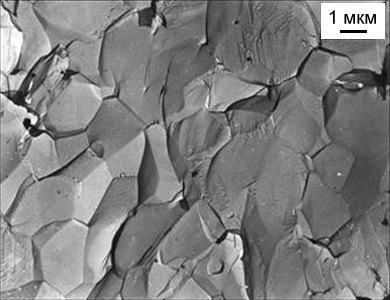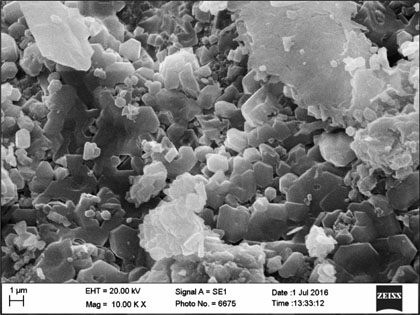
The main direction of the department's work is the development and investigation of the processes, technologies and materials for the compaction and immobilization of radioactive waste (RW).
The department carries out research on the physical substantiation and development of the technologies for immobilization (inclusion in the protective form) of radioactive waste. The technologies being developed for the creation of protective materials are based on the processes of sintering of powder materials, including sintering under pressure (hot pressing, hot isostatic pressing). The use of these technologies makes it possible to obtain protective ceramic materials characterized by high radiation and corrosion resistance.
The department consists of 5 groups, which include 14 researchers. Among them there are 1 Doctor of Sciences and 3 PhDs.
The experimental results have been published in more than 500 publications. Click here to see a more detailed list.
Main directions of work
Main directions of activity:
– development of scientific foundations for the methods and processes of compaction and immobilization of radioactive waste into protective ceramic and glass-ceramic forms for temporary storage and final geological disposal;
– materials science research on the production of high-strength and radiation-resistant ceramics for functional purposes.
Research programs:
– "Departmental order of NAS for scientific research on nuclear science and technology of NSC KIPT";
– targeted complex program of scientific research for NAS of Ukraine "Scientific and technical support for the development of nuclear power industry and the use of radiation technologies in the economy sectors";
– targeted complex program of scientific research for NAS of Ukraine "Scientific support for the development of the nuclear power complex and promising nuclear technologies";
– targeted complex program of scientific research for NAS of Ukraine "Nuclear and Radiation Technologies for the Energy Sector and Public Needs".
Major achievements
Under the cooperation with the Argonne National Laboratory (USA), the manufacturing process for the phosphate ceramics KMgPO4 · 6H2O was developed for immobilization of radioactive waste. Complex testing of the obtained materials for strength, corrosion and radiation resistance was carried out and positive results were obtained. Based on the results of work, the papers were published in the leading foreign journals: "Journal of Nuclear Materials" and "Journal of Hazardous Meterials" (Elsevier).
The method for obtaining transformation-strengthened ceramics based on Al2O3 and ZrO2 was developed using nanopowders as the initial components, as well as special dispersing additives. The developed technology makes it possible to obtain thin-walled products, including those of complex configuration and uniform distribution of properties throughout the entire volume of the sample. The obtained ceramics is characterized by high values of ultimate strength in bending and crack resistance, which is similar to the imported counterparts. The results of work were published in the leading journals "Ceramics International" (Elsevier).
In order to develop an Accident Tolerant Fuel (ATF), the technology for producing dispersion-strengthened composite ceramics based on SiC was created. High-density SiC–ceramics with improved mechanical and corrosive properties was produced using high-speed hot pressing of finely dispersed SiC powder doped with metallic Cr.
International projects:
– Partner project under the IPP program (Contract ANL–T2–0248UA, STCU P–547) “New protective barriers for the containment and immobilization of radioactive materials”, partners: Argonne National Laboratory (ANL) and Boron Products LLC (USA), 2012 – 2014.
– Partner project (STCU P–680) "Chemically Bonded Silico-Phosphate Sprayable Ceramics". Partner: Ceramicoat International Inc. (Canada), 2016.
In recent years, there appeared a new direction of research in relation to the work plan of Euratom on the European Joint Program in Radioactive Waste Management and Disposal (EJP1), namely, the study of the behavior for compacted bentonite clay (as a buffer material in the system for geological removal of RW) at different temperatures (100 – 150°С). The participation of the ISSPMT team in the consortium of executors for this program has been approved and the funding has been provided for 2019 – 2024.
Together with the Argonne National Laboratory and the Superior Graphite company (USA), the unit for consolidation of powdered molds for ceramics of various compositions was developed, manufactured and put into operation both in the protective atmosphere of inert gases and in vacuum (≥ 1.0 Pa).
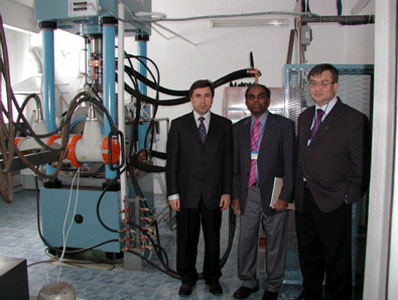
Acceptance of the electrical consolidation unit for commissioning within the STCU Р–154 project, 2009.
From left to right:
S.Yu. Sayenko (work coordinator from NSC KIPT),
Dr. Sami Gopalsami (collaborator from ANL, USA),
M.V. Savoskin (Donetsk Institute of Physics and Technology).
Obtaining functional and composite nanostructured materials:
– research and methodological recommendations for obtaining ultradispersed (including nanosized) powders for the manufacture of functional ceramics based on ZrO2, Al2O3, MgO, Y2O3 and composites on their basis;
– investigation of the methods for molding ceramic blanks from ultradispersed powders by slip casting and pressing;
– manufacture of ceramic products for various purposes and configurations that are similar in their physical and mechanical properties to foreign analogues.
Equipment for the manufacture and sintering of high-strength oxide ceramics.
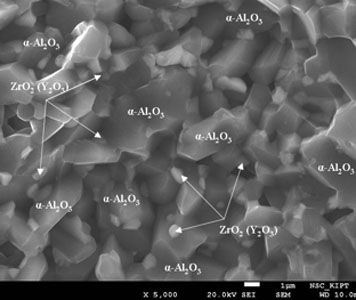
Isolation of RW - development of new protective radiation- and corrosion-resistant ceramic materials
For reliable storage of RW, the protective oxide ceramics based on Al2O3 and modified with fine particles of stabilized zirconium oxide ZrO2(Y2O3) was developed. The development of finely dispersed structure with the uniformly distributed ZrO2(Y2O3) additive in the Al2O3 structure made it possible to improve the strength characteristics of ceramics:
– crack resistance - by 30%;
– resistance to bending - by 25%;
– hardness - by 10%.
A pilot batch of protective containers was manufactured for the Ukrainian State Association "Radon".
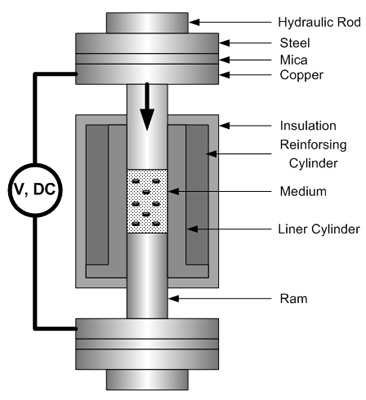
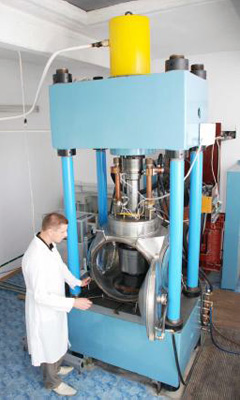
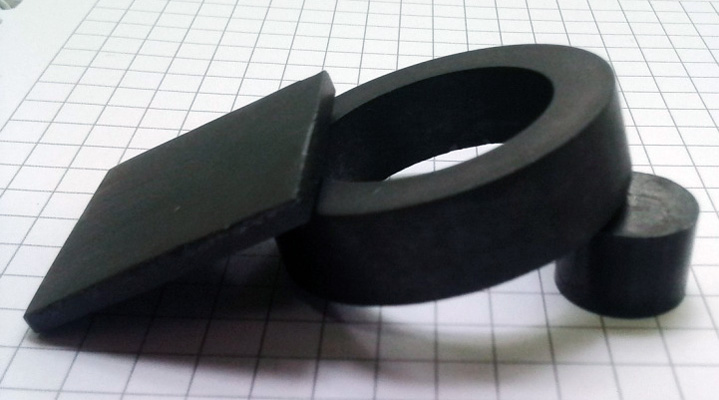
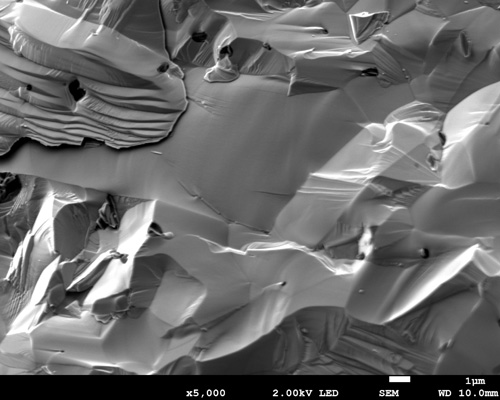
The activities on the synthesis and sintering of refractory ceramic compounds in vacuum at high temperatures (up to 2500°С) with the heating rate of up to 400°С/min are carried out in the department by the method of high-speed hot pressing (HSHP). The diagram for the HSHP method, HSHP unit, products based on silicon carbide (SiC), microstructure (SEM) of SiC ceramics obtained by the HSHP method are shown in the figure.
Department structure
– Organizational and Technical Support Group.
The group is engaged in the material, technical and organizational support of the department's work.
– Experimental Equipment Development Group.
The group's work is aimed at designing the equipment and tooling; research in the field of encapsulation of spent nuclear fuel and radioactive waste using ceramic protective materials; mathematical modeling of thermophysical processes for radionuclide migration in the geological massif of the RW disposal zone.
– Group of technological research on the processes of obtaining materials.
The group conducts materials research on ultradispersed powders and ceramic materials of oxide composition for RW isolation in nuclear power industry and production of new functional ceramics for other industries, development of various methods for the formation and sintering of ceramic prototypes, their analytical research and testing.
– Group of research and development of properties for ceramic materials.
The main directions of the group's activity are the development of radiation- and corrosion-resistant ceramic and glass-ceramic materials for RW conditioning; research on the structure, composition, physical and mechanical properties of the compounds obtained by the advanced methods of molding, sintering, hot pressing and hot isostatic pressing.
– Group for studying the effect of high pressures on materials.
The tasks of the group include studying the effect of high pressures on the physical, mechanical and operational properties of various materials, technical support for the operation of gasostatic equipment, hot vacuum pressing and heat treatment in various environments (vacuum, air, inert gases).
Publications
Employees
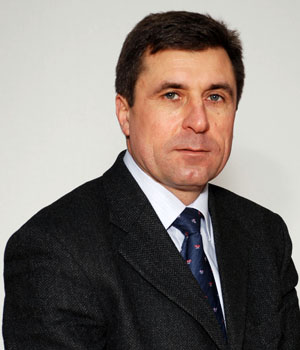
SAENKO SERGEY YURIEVICH
Head of the Department
Doctor of Technical Sciences by the specialty 21.06.01 - "Environmental Safety"
Senior Researcher
Phone. +38(057) 349-10-47
Fax. +38(057) 335-39-05
e-mail: sayenko@kipt.kharkov.ua
Research interests:
development of new radiation- and corrosion-resistant materials and technologies of their manufacture for radioactive waste isolation. In the past five years, the main activities have been focused on the following: investigations in the field of encapsulation for the spent nuclear fuel and radioactive waste using glass-ceramic shielding materials; scientific and administrative management of the scientific department for the implementation of work under the state programs for the development of atomic science and technology.
Activities outside the NSC KIPT:
– the member of the Editorial Board of the journal "Nuclear and Radiation Safety";
– the member of the Euratom platform for isolation and geological disposal of radioactive waste.
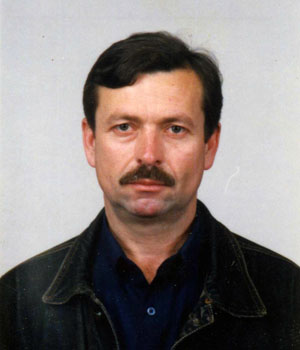
SHKUROPATENKO VLADIMIR ANTONOVICH
Senior Researcher
PhD in Physicals and Mathematics by the specialty 01.04.07 - "Solid State Physics"
Senior Researcher
Phone. +38(057) 335-39-05
e-mail: shkuropatenko@kipt.kharkov.ua
Research interests:
materials science research and development of the technological processes for obtaining ceramic mineral-like materials (apatite, pyrochlore, zircon, NZP-ceramics and others), which can be used as a matrix for safe storage and geological disposal of radioactive waste.
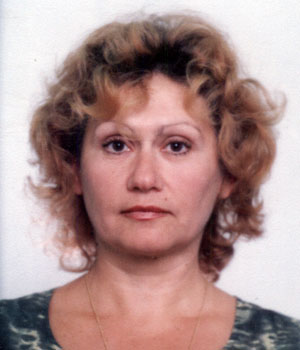
ZYKOVA ANNA VENIAMINOVNA
Senior Researcher
PhD in Physicals and Mathematics by the specialty 01.04.07 – "Solid State Physics"
Phone. +38(057) 335-39-05
e-mail: zykova.anya@gmail.com
Research interests:
investigations on the formation of nanostructured ceramic materials and coatings using modern technologies. Studying the structure and properties of matrix insulating materials for the immobilization of radioactive waste in nuclear power engineering and production of new functional materials for other industries. Development of the optimal modification regimes for the nanostructured materials and surfaces for structural, tribological and biomedical applications. Studying the structure and properties of ceramic materials using modern analytical methods.
Activities outside NSC KIPT:
– member of the Editorial Board of the “Scientific Journal of Gdynia Maritime University” (Gdynia, Poland).
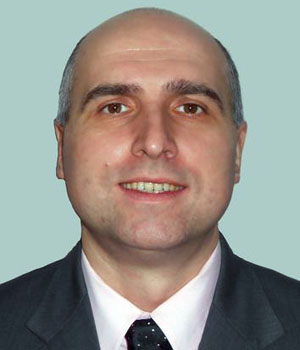
SVETLICHNYI EVGENIY ALEXANDROVICH
Senior Researcher
PhD in Technical Sciences by the specialty 05.17.11 - "Technology of refractory non-metallic materials"
Phone. +38(057) 335-39-05
Research interests:
development and material science studies of oxide ceramic materials for the isolation of radioactive waste in nuclear power engineering and the production of new functional ceramics for other industries, development of various methods for the formation and sintering of ceramic prototypes, their analytical investigation and testing.
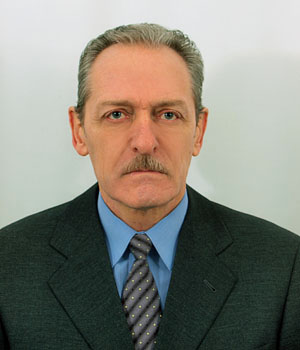
KHOLOMEEV GENNADIY ALEXANDROVICH
Researcher
Phone. +38(057) 335-39-05
Research interests:
development of the materials, technologies and equipment for radioactive waste isolation. Investigations in the field of encapsulation of spent nuclear fuel and radioactive waste using ceramic shielding materials. Mathematic simulation of thermophysical processes and processes of radionuclide migration in the geological massif of the radioactive waste disposal zone.
